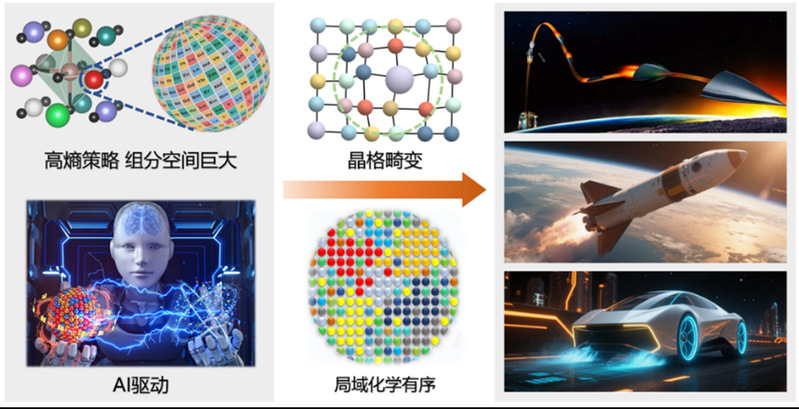High-entropy ceramic composites
2025-09-29
1. AI-Driven High-Entropy Ceramic Materials
High-entropy ceramic materials exhibit a wide variety of compositions and an enormous compositional space. This makes the development of high-entropy ceramics using traditional trial-and-error approaches time-consuming and costly. This project aims to establish a novel AI-driven paradigm for the research and development of high-entropy ceramic materials by integrating multiscale material simulations and high-throughput experimental techniques. Through high-throughput atomic-scale computations and high-throughput synthesis and testing of macroscopic materials—from the atomic level to the macroscopic scale—we will build a foundational database to train reliable AI models. These models will enable efficient prediction of new high-entropy ceramic materials with targeted properties (such as low thermal conductivity, high hardness, and high modulus). Furthermore, we will uncover the structure–property relationships between composition, microstructure, and performance, and employ inverse design to optimize material performance, composition, and synthesis/sintering process pathways. This approach will facilitate the efficient design and development of a series of advanced high-entropy ceramic materials.2. High-Entropy Thermal Protection Ceramic Materials
The development of next-generation hypersonic vehicles and reusable spacecraft imposes higher demands on thermal protection systems for critical structural components, such as oxidation and corrosion resistance at ultra-high temperatures, superior thermal insulation, and long-term stability. This project leverages the high-entropy strategy to redesign material genomes, combined with advanced techniques such as ultrafast ultra-high-temperature sintering, plasma sintering, and first-principles calculations. We aim to reveal typical brittle fracture characteristics at the atomic scale, multi-element synergistic antioxidant mechanisms, and lattice-distortion-induced strengthening hardening effects in high-entropy materials. The goal is to develop new ultra-high-temperature-resistant high-entropy ceramic materials with extremely high melting points, low thermal conductivity, excellent oxidation resistance, and superior resistance to CMAS (calcium-magnesium-alumino-silicate) corrosion. These materials will serve as reliable structural components for next-generation hypersonic vehicles and reusable launch systems.3. High-Entropy Stealth Ceramic Materials
Modern defense technologies demand stealth materials with integrated thin, light, broad, and strong performance characteristics. This project focuses on the development of a new generation of multifunctional stealth coating materials. We systematically investigate the influence of factors such as lattice distortion, defects, and localized metal chemical ordering on the electromagnetic wave absorption properties of high-entropy ceramic materials, aiming to uncover intrinsic mechanisms that enhance wave absorption. By enabling precise design of the dielectric and magnetic properties of high-entropy ceramics, we seek to significantly improve key absorption parameters such as bandwidth. The outcome will be high-entropy stealth coating materials with outstanding stealth functionality.4. High-Entropy Energy Ceramic Materials
To meet the growing demand for efficient and stable inorganic energy conversion and storage materials, high-entropy energy ceramic materials hold tremendous potential and application prospects in fields such as thermoelectric energy, battery electrodes, dielectric energy storage, photoelectric conversion, and nuclear energy. They represent one of the key materials capable of breaking through the bottlenecks of current energy technologies. The vast compositional space and stable crystal structures of high-entropy energy ceramics allow for the breakthrough of limitations inherent in conventional single-component energy materials through rational composition design and regulation. This enables the realization of features such as high-speed ion transport channels, high photoelectron activity, excellent resistance to carbon deposition and sulfur poisoning, and exceptional radiation tolerance. These properties not only significantly enhance energy conversion efficiency but also improve the operational performance of energy devices, enabling them to function stably over the long term even in harsh environments.

